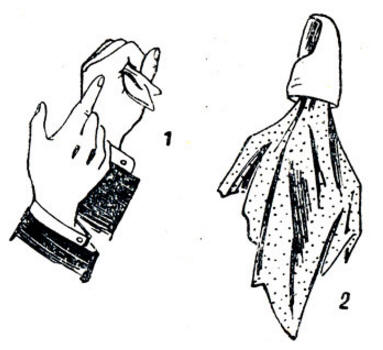
|
|
EFFECTIVE FOCUSES AND THEIR CLUES Disappearance of handkerchief. Focus Secret
Directory / Spectacular tricks and their clues Focus Description: The magician shows the audience a large beautiful silk scarf, then takes it in his palms and, waving both hands, gradually begins to take the scarf inside his left palm, covering it with his right. The scarf gradually becomes smaller and smaller, finally, the audience sees only one corner of it. The performer draws the attention of the audience to this corner (Fig. 59, 1).
Then, with the index finger of his right hand, the artist gradually tucks the corner inside his left palm, takes his right hand away, unclenches it, and everyone clearly sees that there is nothing there. Fixing the attention of the audience on the left palm, clenched into a fist, the illusionist makes a rubbing movement with the fingers of his left hand and gradually opens his fingers. The handkerchief from the left hand disappeared. Showing both hands empty, the magician puts his right hand into his pocket and pulls out the missing handkerchief. Props: Large thin beautiful silk scarf. Celluloid imitation of a fingertip with a nail, painted to match the color of a magician's hand (Fig. 59,2). The corner of the scarf is exactly the same in design and color as shown to the audience. Focus secret: The secret of the trick breaks down into several parts: the "disappearance" of the large handkerchief, the replacement of the handkerchief with a corner, and, finally, the "disappearance" of the corner itself. Before starting the trick backstage, the performer carefully tucks the corner of the handkerchief into a celluloid imitation of the fingertip and places it in the left vest pocket in such a position that the tip can be freely put on the index finger. At the beginning of the performance, putting an imitation on the right index finger, the artist makes sure that the right hand is not at all motionless for a single moment, otherwise the audience may notice the substitution. A large handkerchief is taken with the right hand (in this position, the tip of the finger is easy to hide from the audience) and shown from all sides. Then the magician very slowly begins to take it inside the left palm. In this manipulation, he swings his arms up and down all the time. Gradually, with the fingers of the left hand, the performer rolls the handkerchief into a compact tight ball. The right hand at certain moments is retracted from the left, and all the attention of the audience is focused on the handkerchief in the left hand. When almost the entire handkerchief is already gathered in a ball in his left hand and only a corner remains, approximately the same size as the corner in the tip of a false finger, the illusionist waves his hands, for a moment stands with his left side towards the audience and under the cover of this distracting moment, quickly raises his right hand to the left. Putting his index finger into the palm of his left hand, he removes the imitation from the finger; with the same movement, he pulls out a corner of a handkerchief from the tip of his finger, covers the corner of a large handkerchief with it; all the while both hands move slowly up and down; under the cover of this movement and rotation of the body, the conjurer quickly takes the folded handkerchief into his right hand and carefully hides it in the fist of his right hand; putting forward his index finger, he points to the tip of the handkerchief (see Fig. 59, 1). Then, having chosen a convenient moment, the performer quickly lowers the scarf with his right hand into the right pocket of his trousers or jacket (it can also be in the neckline of the vest) and again points with his index finger at the tip of the scarf, at the same time with his left thumb he begins to push the corner into the false finger, helping with the index finger of his right hand . Having pushed the tip of the handkerchief, the artist quickly and imperceptibly puts on a false finger with the corner of the handkerchief in it on the end of the right middle finger; presses it inside the palm of his hand, and again points to his left hand, as if holding a handkerchief in his fist. Then slowly opens the left hand and shows it, as well as the right hand from all sides; he puts his right hand into his pocket, where the handkerchief lies, and, taking it by the end, supporting it with his left hand, slowly takes it out and shows it to the audience. Despite the complexity of the description, this trick is very simple, but, of course, it requires a lot of practice in front of the mirror, the development of precise movements and clarity of execution. Author: Vadimov A.A.
Solidification of bulk substances
30.04.2024 Implanted brain stimulator
30.04.2024 The perception of time depends on what one is looking at
29.04.2024
▪ ASRock H81TM-ITX R2.0 Motherboard ▪ The northern hemisphere is facing the hottest summer in 600 years ▪ The colonization of Mars is not far off
▪ site section Welding equipment. Article selection ▪ Article Spring Dreams. Popular expression ▪ article Why don't samurai serve in the Japanese police? Detailed answer ▪ article One-track sled. Personal transport ▪ article Refinement of the USB hub. Encyclopedia of radio electronics and electrical engineering
Home page | Library | Articles | Website map | Site Reviews www.diagram.com.ua |






 Arabic
Arabic Bengali
Bengali Chinese
Chinese English
English French
French German
German Hebrew
Hebrew Hindi
Hindi Italian
Italian Japanese
Japanese Korean
Korean Malay
Malay Polish
Polish Portuguese
Portuguese Spanish
Spanish Turkish
Turkish Ukrainian
Ukrainian Vietnamese
Vietnamese


 See other articles Section
See other articles Section 